Posted by Kristen Goodhue on July 31st, 2012
by Megan Riley
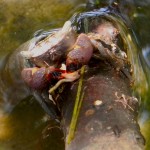
A large adult male Aratus eating a juvenile of its species. (Megan Riley)
As adults, mangrove tree crabs
(Aratus pisonii) tend to forage on fresh mangrove leaves in the canopy. As omnivores, they will also prey on nitrogen-rich insects, larvae, and even juveniles of their own species. However, it’s unclear how these organisms balance their nitrogen requirements and other nutritional demands. This summer I have focused my research on addressing this question. Specifically, I am investigating how their diet choices affect their overall health and ability to reproduce.
In order to perform this research, I first have to catch the Aratus! Despite the abundance of these animals in mangrove stands on the Indian River Lagoon, tree crab hunting is a tricky business. Over the course of the summer, I’ve learned a number of tips for trapping the elusive crustacean…
Click to continue »
Posted in Climate Change, Ecology, Invasive Species, Mangrove Tracking: Letters from the Field | 1 Response »
Posted by Kristen Goodhue on July 24th, 2012
by Cora Johnston
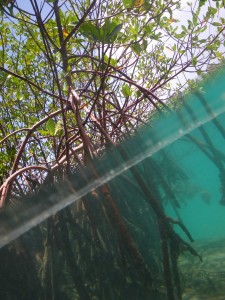
The waters beneath mangroves are teeming with marine life, in part due to the refuge provided by the tangled complexity of their underwater roots. (Cora Johnston)
From salty branches to mucky roots, mangroves are teeming with life. Although many people recognize mangroves as spindly trees emerging right out of the water, it is under the water’s surface that mangroves really come alive for a marine ecologist like me. (That is also where you start to appreciate red mangroves’ apt name.)
Mangrove roots, both dangling from above (prop roots) and growing up from the sand (pneumatophores), not only mine for nutrients and allow for oxygen and carbon dioxide exchange for the plant; they also provide apparently crucial food and refuge for a stunning array of marine species. Fish, worms, crabs, shrimp, barnacles, and many other organisms take shelter among the roots – gluing right to the wood, hiding in crevices, and peering out through the maze. In such harsh intertidal conditions, where waves break, salt builds up, and the sun beats down, the shade and nooks formed by mangroves may be the key to survival for juvenile fish and crustaceans that will someday populate coral reefs and fishing hotspots farther offshore.
Over the coming months, I will be investigating how and why young fish and crustaceans use mangroves and marshes. By understanding the refuge provided by these very different coastal plants, I hope to better understand how the northward march of mangroves will influence the survival, abundance, and composition of marine species utilizing these now changing coastal nurseries.

Juvenile fish and crustaceans find safety in red mangrove roots during the early, vulnerable stages of their life. This young barracuda may be looking for a snack while hiding from larger predators. (Cora Johnston)
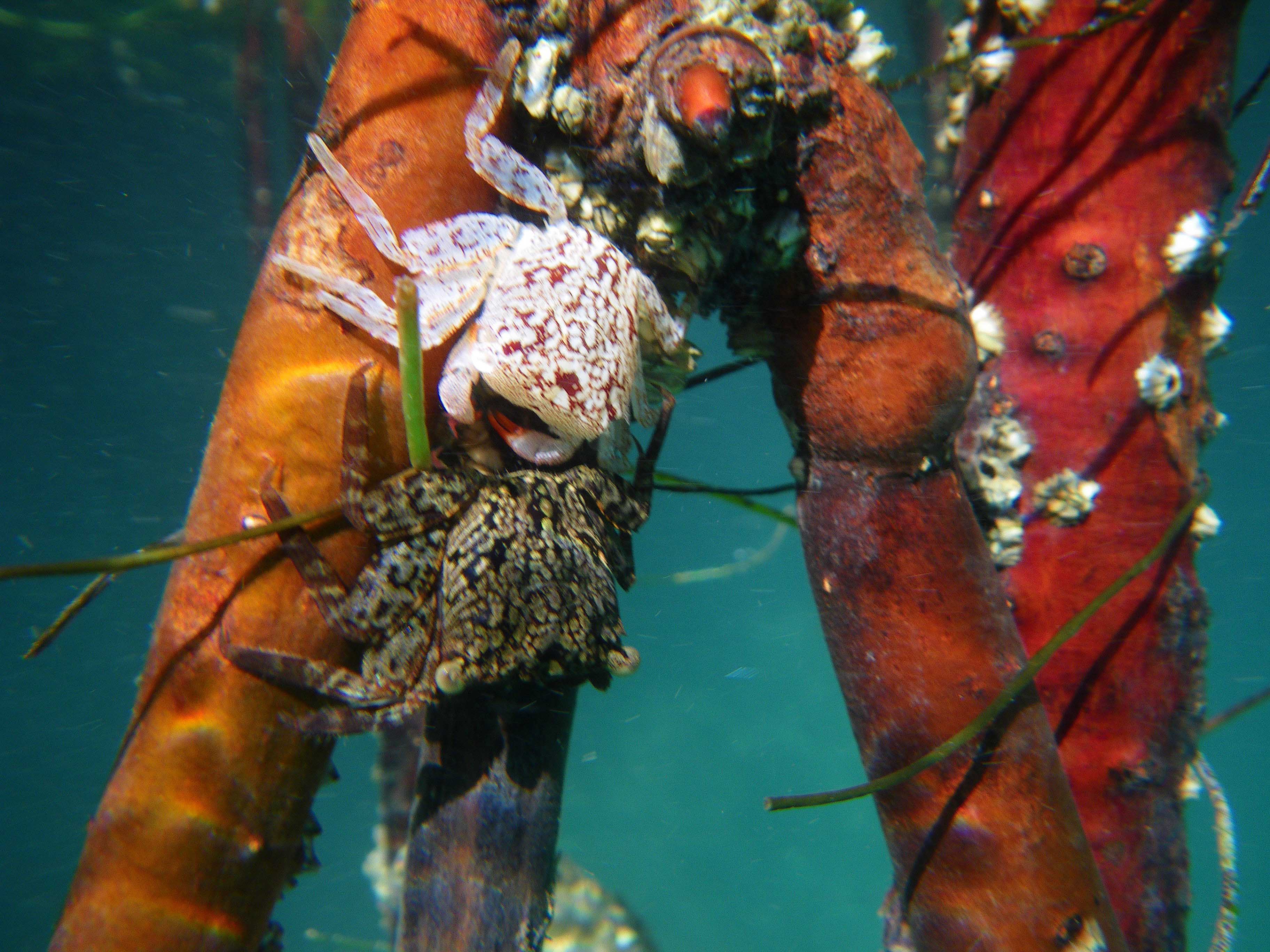
Even mangrove tree crabs that spend most of their time foraging in the canopy climb down to the safety of the mangrove roots to shed their old exoskeletons and harden their new ones. (Cora Johnston)
-Cora Johnston is a PhD student at the University of Maryland. This material is based upon work supported by the National Science Foundation under Grant Number 1065098. Any opinions, findings, and conclusions or recommendations expressed in this material are those of the author(s) and do not necessarily reflect the views of the National Science Foundation.
More stories from the mangroves >>
Posted in Climate Change, Ecology, Fisheries, Invasive Species, Mangrove Tracking: Letters from the Field | Comments Off on Mangrove Tracking VIII: Beneath the Waves
Posted by Kristen Goodhue on July 16th, 2012
by Nancy Shipley
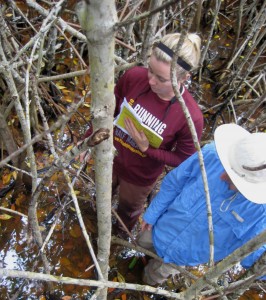
Technician Lorae Simpson and intern Jake Bodart deep in the mangroves, assessing vegetation cover and substrate color. (Mayda Nathan)
It sometimes seems crazy to be climbing through mangrove stands and wading through large ponds to collect our data, but the sites we explore are chosen for a reason. That reason is two-fold: One, to ground truth satellite imagery so we can map historic and current mangrove distributions. Two, to document the plant communities in places dominated by mangroves, in places where mangrove encroachment is occurring, and in places where mangroves have not yet arrived.
By using satellite imagery from years past, we hope to determine how far mangrove communities have spread in the last few decades. To do this we have to first understand what individual plant species comprise the large areas of vegetation that we can see from the satellites.
That is where we come in, climbing through mangroves.
Click to continue »
Posted in Climate Change, Ecology, Grants, Interns, Invasive Species, Mangrove Tracking: Letters from the Field | Comments Off on Mangrove Tracking VII: Just Another Day at the Office
Posted by Kristen Goodhue on July 5th, 2012
by Jake Bodart
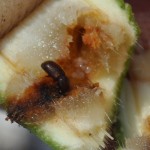
Beetle tunnel. This Scolytid beetle has burrowed into a mangrove seedling and lain its larvae inside. (Jake Bodart)
In science not everything goes according to plan. For example, half of your project’s experimental units might die before you start.
In the back of the Smithsonian Research Station here in Ft. Pierce, the mangrove team has built an artificial pond (we call it Lake Simpson) to raise mangrove seedlings that will be used in experiments. However, when we arrived here last month, we noticed that about half of the red mangroves were turning black and dying. It was unclear at first whether these mangroves were dying directly as a result of the artificial habitat (was our pond too hot? Too salty? Not salty enough?), or if the pond was somehow making the mangroves more susceptible to pest insects. We know from other studies that predation by insects can cause a large amount of propagule and seedling mortality.
Upon closer inspection, we decided insects were the culprit. The evidence of insect predation: small bore holes and little piles of frass (chewed up/excreted parts of the plant, a.k.a. insect poop). We decided to sacrifice the seedlings that were clearly infested, and dissect them to see if there were any insects inside.
Click to continue »
Posted in Climate Change, Ecology, Grants, Interns, Mangrove Tracking: Letters from the Field | Comments Off on Mangrove Tracking VI: Attack of the Beetles
Posted by Kristen Goodhue on July 3rd, 2012
by Kristen Minogue
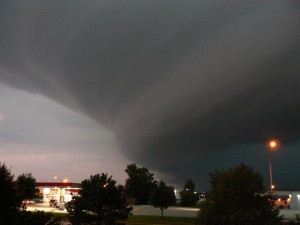
Derecho storm front over Nebraska in August 2007. (MONGO)
To say the tempests of June 29 took the U.S. by surprise would be an understatement. Near Annapolis, the storms jumped from a mild 10 miles per hour to 54 miles per hour in just five minutes. In other places 70- and 80-mile per hour winds tore through hulking trees and power lines. And yet the most violent part of the storm lasted less than half an hour.
“It all happened in a matter of minutes….I’ve never seen anything like it,” said ecologist Pat Neale, who tracked the wind speeds on SERC’s meteorological tower.
How could something so quick cause so much damage? And how would a storm like that form in the first place?
Click to continue »
Posted in Climate Change, Ecology, Extreme Weather, SERC Sites and Scenes | 3 Responses »
Posted by Kristen Goodhue on June 27th, 2012
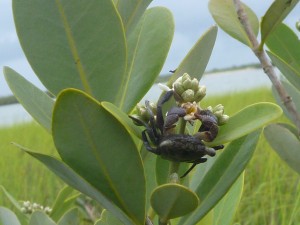
Mayda Nathan/University of Maryland
Today we spotted a mangrove tree crab (
Aratus pisonii) enjoying nectar from a black mangrove flower. It was surprising enough to find Aratus all over these black mangroves, at the very northern edge of the mangrove range in Florida; it was even more astonishing to see this one’s very un-crablike behavior! Aratus are known omnivores – consumers of mangrove leaves, propagules, insects, even other Aratus – but we’ve never thought of them as floral visitors. They are normally extremely shy, but this particular Aratus was so blissed out by its sugary meal that it didn’t mind (or notice) as we snapped pictures and gawked.
–Mayda Nathan, graduate student (University of Maryland)
This material is based upon work supported by the National Science Foundation under Grant Number 1065098. Any opinions, findings, and conclusions or recommendations expressed in this material are those of the author(s) and do not necessarily reflect the views of the National Science Foundation.
Posted in Climate Change, Ecology, Grants, Invasive Species, Mangrove Tracking: Letters from the Field | Comments Off on Mangrove Tracking V: A Maverick Crab
Posted by Kristen Goodhue on June 26th, 2012
by Dan Gruner
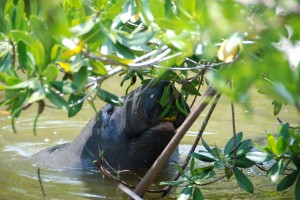
A manatee samples red mangrove leaves and its cigar-shaped propagules. Photo: John Parker
Our task this week was to begin “ground-truthing” locations on the map to evaluate them for suitability as field study sites. This was basic reconnaissance, otherwise known as exploring (or just mucking about). It’s always exciting to visit new sites. For me, recon missions recall childhood Christmas mornings, with the anticipation of finding treasure in the stacks of wrapped boxes under the tree. What treasure will we find in the marshes and mangroves?
Even with the tremendous leaps we’ve gained from satellite imaging, Google Earth and other technologies, experience on the ground (or in the water) is irreplaceable. Our team must build a network of sites along the lagoons and estuaries of the Florida coast, and ultimately the globe, to understand the causes and consequences of shifts in the range of tropical mangrove species. On this day we probed several mangrove and salt marsh estuaries along the Indian River Lagoon. We tested technologies allowing real-time exploration of satellite imagery while comparing that imagery to landscape and vegetation features we saw on the ground. This was GPS on steroids! By allowing us to optimize site selection and replicate sites all along the coast, these technologies will help us characterize the vegetation of the estuaries and how they’ve changed over time.
But that day our attention was drawn away from new technology to something much older (about 50 million years old): manatees. Click to continue »
Posted in Climate Change, Ecology, Mangrove Tracking: Letters from the Field | 1 Response »
Posted by Kristen Goodhue on June 22nd, 2012
Mangrove research is not glamorous work.

Researchers Lorae Simpson, Jake Bodart, Nancy Shipley and Mayda Nathan ford across a mangrove-surrounded pool. (Brian Thompson)
Don’t let the tropical locales and boat-to-work daily routine fool you; research in mangroves requires high tolerance for heat, biting bugs, dirt and wet. But the impenetrability of mangroves means that scientific understanding of this ecosystem has lagged somewhat behind other terrestrial environments. And this lack of information is like a magnet for ecologists.
Our team has descended on the Florida mangroves this summer to study the insects that live in and on them, the fish that find shelter among their submerged roots, the dietary choices of the crabs that live in their branches, their reproductive biology, and the interactions between the three mangrove species found here and their marsh plant neighbors. Taken together, our efforts will contribute to a better understanding of the communities that assemble as mangroves spread north into the northern Florida saltmarshes.
This means we spend some days struggling through thickets of mangroves, waist-high patches of pickleweed, and neck-deep pools of brackish water. In building up a research program, we’re building a lot of character, too.
More stories from the mangroves >>
-Mayda Nathan, graduate student (University of Maryland)
This material is based upon work supported by the National Science Foundation under Grant Number 1065098. Any opinions, findings, and conclusions or recommendations expressed in this material are those of the author(s) and do not necessarily reflect the views of the National Science Foundation.
Posted in Climate Change, Ecology, Grants, Invasive Species, Mangrove Tracking: Letters from the Field | Comments Off on Mangrove Tracking III: The Glories of Field Work
Posted by Kristen Goodhue on June 18th, 2012
by Cora Johnston
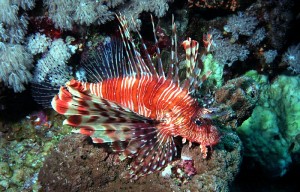
Red Lionfish. Photo: Jacek Madejski
This just in: Invasive and venomous lionfish
(Pterois volitans) have just been spotted in mangroves along Florida’s Atlantic coast! We encountered two individuals of this invasive species (they’re native to the Indian and Pacific Oceans) while conducting snorkeling fish surveys along the Indian River Lagoon.
Click to continue »
Posted in Climate Change, Ecology, Grants, Invasive Species, Mangrove Tracking: Letters from the Field | Comments Off on Mangrove Tracking II: Invasive Lionfish
Posted by Kristen Goodhue on June 13th, 2012
by Tuck Hines
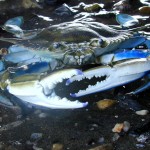
Smithsonian Environmental Research Center
Few creatures in Chesapeake Bay have experienced the kind of whiplash felt by the blue crab. Having gone through a near-disastrous decline that lasted almost two decades, they made a dramatic comeback starting in 2009. But before managers could proclaim it a success, the numbers fell again. And this time, the reasons aren’t so clear.
Click to continue »
Posted in Ecology, Fisheries | 1 Response »













